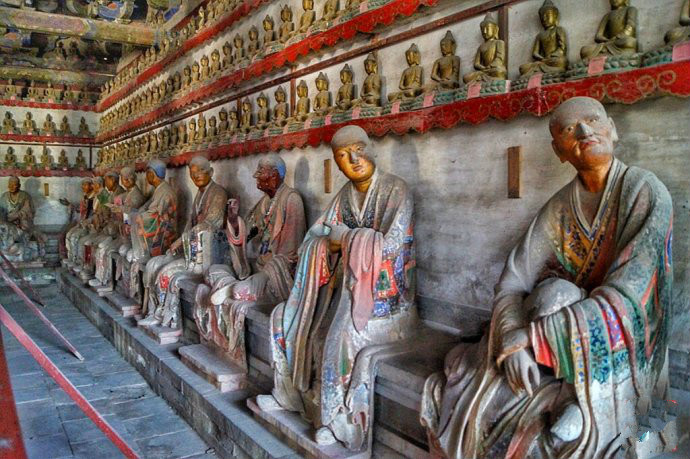Arhat sculptures in Lingyan Temple embody characteristics of Song artworks

The artistic characteristics of Arhat sculptures in the Lingyan Temple reflect the secularization of art in the Song Dynasty.
Temple sculptures from the Northern Song Dynasty can mostly be found today in Shandong, Shanxi and Jiangsu Provinces.
Lingyan Temple, with a history of more than 1,600 years, is located in Changqing District of Jinan, Shandong Province. It was originally established in the Eastern Jin Dynasty, rebuilt in the Northern Wei Dynasty and flourished in the Tang Dynasty. The Arhat sculptures in the temple have dynamic facial expressions and are depicted in vivid poses. They capture the figures’ characteristics and fine details, including muscles and wrinkles. Liang Qichao, a modern thinker, politician and historian, once said that the painted clay sculptures of Arhat in the Thousand Buddha Hall of the Lingyan Temple are the finest sculptures in China.
The Song-painted sculptures of the Lingyan Temple have outstanding artistic characteristics.
In terms of modeling, sculptors at the Lingyan Temple had absolute confidence in the sculptures’ form and structure, and clearly understood proportions. For example, it’s generally difficult for sculptors to make thin figurines, because it’s not easy to engrave these figurines’ obvious brow ridges, skull and lower jawbone. However, the sculptors of the Lingyan Temple utilized their superb skills to make it possible. They endowed these exquisite sculptures with three dimensions and artistic expression. The main colors of the sculptures’ clothes are white, red, blue, green and yellow. Assorted colors and ornamental patterns give sculptures a range of styles.
This artistic modeling style indicates that art was close to life and was used to depict ordinary people’s daily lives in the Song Dynasty.
These sculptors are anonymous, but without question they are outstanding artists. They never used superficial or fancy skills to please anybody in their artistic creations, but instead aimed to depict the qualities of their subjects, portraying their profound personal characteristics and inner world.
So how did these Lingyan Temple sculptors create such a simple but realistic art style in the Song Dynasty?
The boom in agriculture and the handicraft industry in the Song Dynasty accelerated the prosperity of urban commerce, and urban demand became a new aspect of society. Moreover, the textile industry in the Northern Song Dynasty mainly focused on silk fabrics. Silk fabrics were one of the most significant sources of national revenue at that time, which also prompted people to put an emphasis on the ornaments and technological skills involved in creating sculptures.
In terms of politics, foreign aggression was always an issue threatening the regimes of the Song Dynasty. As of the mid-Song Dynasty, the royal court paid tribute to sue for peace and temporary comfort. Under these circumstances, ordinary people pinned their hopes on deities to solve earthly problems. In addition, the development of urban commercialization drove social consciousness, and the image of deities became secular and down to earth.
From the aspect of art and ideology, after Emperor Huizong in the Song Dynasty established an imperial art academy, the realistic style developed. Compared to paintings at that time, sculptures were three-dimensional art and more closely reflected people’s daily lives. They showed the popularization of both art and Buddhism in the Song Dynasty.
The artistic characteristics of Arhat sculptures in the Lingyan Temple reflected the tendency of art secularization in Song-painted sculptures. Art began to attach importance to real life and embodied the spirit of humanistic concerns.
